Projector
Monitor
Lighting
Interactive Display | Signage
Remote Work & Learning
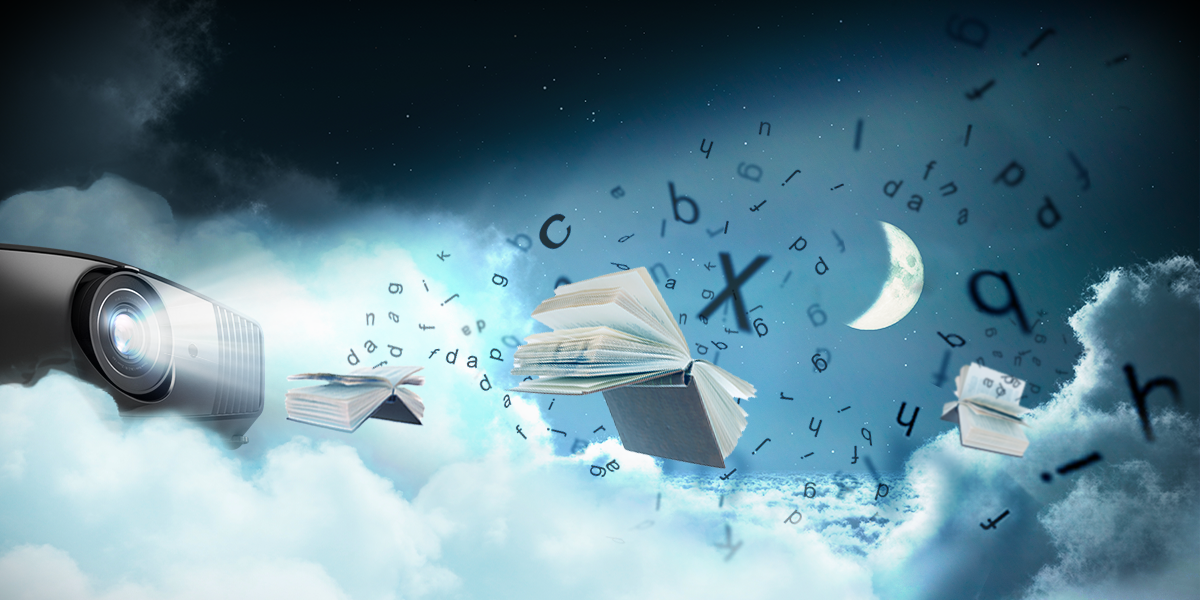
From boardrooms to living rooms, projectors have become an essential part of our daily lives, offering us a larger-than-life viewing experience that few other technologies can match. However, for those who are new to the world of projectors, the technical terminology can be overwhelming. If you're one of those people, fear not! To help you on your quest for the ideal projector, we’ve put together this easy-to-understand guide to the essential terminology of projectors. Whether you're looking to set up a home theater or simply explore the technology behind projectors, this article will give you the foundation you need to get started. So, let's dive in and discover the exciting world of projectors together!
Content Index
A-C: Aspect Ratio, Calibration, Colour Gamut, Colour Temperature, Colour Wheel, Contrast
D-H: DCI-P3, DLP, DMD, Dynamic Iris, Frames per Second (FPS), Gamma, Ghosting, HDMI, HDR, HLG
I-O: Input Lag, Keystone, LCD, Lens Shift, Light Reflection, Lumen, Native Resolution, OSD
N-Z: Native Resolution, OSD, Rec. 709, RGB, Screendoor, Tab Tension, Throw Distance, Upscaling, Zoom
Aspect ratio is an important term to understand when it comes to projectors, as it relates to the proportion of the image displayed on the screen. It is expressed as a ratio of the width of the image to the height of the image.
For example, a 16:9 aspect ratio means that the width of the image is 16 units and the height is 9 units. This ratio is commonly used for high-definition (HD) video and is the standard for many modern projectors. Typical HD/UHD content is 16:9 wide screen, while movie theaters use 2.35:1.
On the other hand, a 4:3 aspect ratio is the older "letterbox" ratio used for standard definition (SD) video (before HD) and is still used in some applications. This means that the width of the image is 4 units and the height is 3 units.
It's important to note that the aspect ratio of your projector should match the aspect ratio of the content you want to display, otherwise the image may be distorted or have black bars on the top or sides of the screen. Many projectors come with adjustable aspect ratios, allowing you to choose the best ratio for your needs.
The professional adjustment of a projector or display to accepted standards such as Adobe RGB, DCI-P3, Rec. 709, and Rec. 2020. If a projector offers good calibration the image you get on your screen stays very close to the source material, or to the way film makers and TV producers wanted the work to be viewed by audiences. In other words, accurate colour means faithful reproduction of content. A poorly calibrated projector may depict a red car as orange, as an extreme example. You certainly don’t want that.
Since colour is effectively energetic light, temperature determines what we see. Temperatures measured in kelvins, with almost all content in the 4000-7000K range. You may encounter the term “D65”. That refers to the temperature of light during daytime and serves as a reference in many colour spaces, including Rec. 709. D65 measures approximately 6500 kelvins.
Colour gamut refers to the range of colours that a projector can produce. It's an important term to understand when it comes to projectors, as the ability to produce accurate and vibrant colours is a key factor in determining the overall picture quality. Projectors typically use different colour gamut standards, the most common of which are the sRGB and Rec. 709 colour gamut standards. sRGB is a widely used standard in computer graphics and digital imaging, while Rec. 709 is a standard used in HDTVs and Blu-ray discs. The colour gamut is typically expressed as a percentage of the colour space that the projector is capable of producing. For example, a projector with a colour gamut of 100% sRGB can produce all the colours within the sRGB colour space.
Component responsible for generating colour in projectors. Basic colour wheels have just three segments: red, green, and blue. Having multiple segments of each primary colour helps produce richer colours and wider a wider colour gamut, so good projectors have RGBRGB colour wheels (two segments per primary colour). Variations exist, such as RGBW (adds a white-dedicated segment) and RGBCWY (red, green, blue, cyan, white, yellow). Colour wheels with high primary colour purity offer the best colour performance.
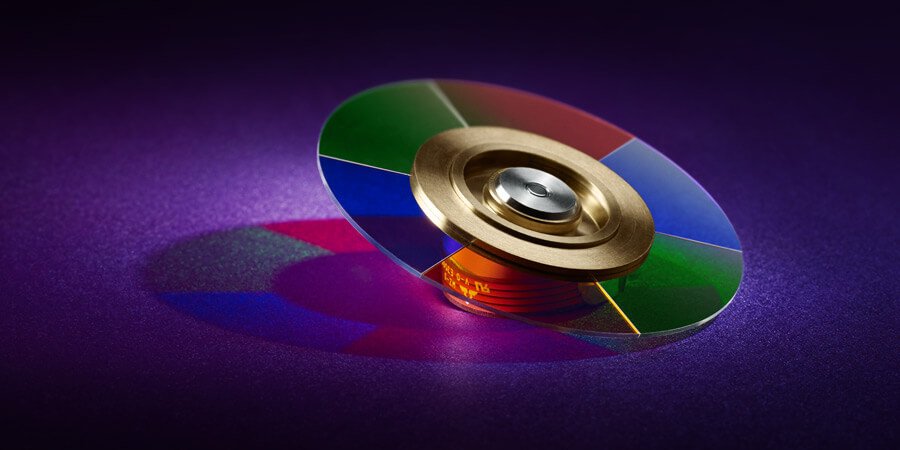
A high contrast ratio means that there is a greater difference between the brightest and darkest parts of an image, resulting in a more dynamic and detailed picture. A low contrast ratio, on the other hand, can make the image look washed out and lack detail. Contrast ratios describe the amount of white per unit of black, for example, 30,000:1. For example, if you're watching a movie on a projector with a low contrast ratio, the black areas of the image may appear more like grey, and the white areas may lack brightness and appear dull. This can make it harder to see details in dark or bright scenes, resulting in a less immersive viewing experience. In contrast, a projector with a high contrast ratio can produce deeper blacks and brighter whites, creating a more vivid and engaging picture. This is especially important for movies with many dark scenes, where details can be lost if the contrast ratio is too low.
DCI-P3 is a colour gamut standard that was developed for digital movie projection in professional cinemas. It's a standard for colour reproduction in many digital cinema projectors and has a wider colour gamut than the sRGB standard used in consumer electronics. DCI-P3 can reproduce more colours, particularly in the green and red parts of the spectrum, resulting in a more vibrant and lifelike image.
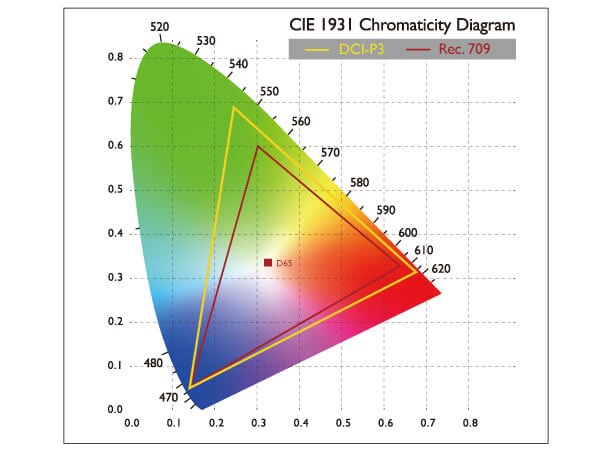
Digital light processing, a technology that uses millions of micromirrors to generate a precise image sent by a powerful light source. Compared to other projection technologies like LCD, DLP mechanisms resist dust build up and don’t require complex filters that end up degrading image quality. Most importantly, the mirrors used in DLP are extremely long-lasting, while LCD panels deteriorate much more quickly. Even if the light source (lamp) requires replacement, image quality remains at peak with DLP, while with LCD quality worsens over time regardless of how new the lamp may be.
Learn more: What’s BenQ DLP Technology?
Digital micromirror device, a precision-crafted component that has millions of tiny mirrors working together with a processor to allow projection of images in resolutions up to true 4K.
A very useful and advantageous mechanism in select projectors that’s integrated between the projector lamp and lens which opens and closes depending on the overall brightness of the projected image to adjust light output. Used to fine-tune the projected image by letting the projector enhance contrast performance, resulting in accurate dark scenes and optimized bright areas, thus preventing the loss of image detail.
Learn more: How does a dynamic iris works?
The number of times a display refreshes per second. The more frames, the smoother video appears. TV and movie content usually uses 24 frames, video games typically run at 30 or 60, but increasingly go up to 144. Often measured in Hertz (Hz).
The way voltage affects brightness. Increasing voltage boosts light output and therefore means a brighter image.
When a source and a display aren’t properly synced, images can appear to have “duplicates” since the source tries to update too fast for the display.
High Definition Multimedia Interface, the most common home media connector and cable standard since the mid 2000’s. HDMI 2.0 and up required for 4K UHD at 60fps.
HDR technology allows for achieving brighter whites and deeper blacks. This creates brighter and more colourful displayed images, making them more realistic and dramatic.
Learn more: What's BenQ HDR-PRO technology?
Hybrid Log-Gamma (HLG) is a version of HDR that was jointly developed by NHK and the BBC. Unlike other forms of HDR, HLG does not use metadata, which means it is compatible with both SDR and HDR displays.
The delay between an image being sent out by a projector and the same image getting displayed on screen. In the context of gaming, also includes the additional delay between the screen and the controller (also known as controller latency). Measured in milliseconds, input lag of over 40ms makes video games essentially unplayable and may cause lip sync issues when watching movies and TV.
When a projector is placed at an angle to the screen, the image can appear distorted. Keystone correction is a feature of projectors that helps to adjust the shape of the projected image when the projector is not placed directly in front of the screen. Most cinematic projectors have manual or automatic keystone correction. Manual keystone correction involves adjusting the projector manually by tilting it or using the keystone correction feature in the projector's menu. Automatic keystone correction, on the other hand, uses sensors or software to detect the angle of the projector and adjust the image accordingly.
Liquid crystal display, one of the leading technologies in TVs and projectors. Different from digital light processing (DLP) in that LCD panels tend to fade and change properties over time, while DLP mirrors retain their initial quality much longer and do not suffer from LCD-typical issues such as hot spotting and image uniformity problems.
Lens shift allows you to adjust the position of the projected image on the screen without physically moving the projector. Instead, it works by moving the lens assembly inside the projector to adjust the position of the projected image up or down, left or right, or diagonally. This feature provides greater flexibility in image placement, particularly when the projector is in a fixed location. Some projectors have both horizontal and vertical lens shift, allowing for greater precision and control over the position of the image. It's important to note that lens shift is not the same as keystone correction. While keystone correction adjusts the image's shape, lens shift adjusts the position of the image.
Important aspect of projector screens. The more light a material reflects, the better it is for use with projectors. Light rejection technologies increase the amount of light that reaches viewers.
Popular unit for measuring total light output and brightness.The brightness of the projected image is determined by the number of lumens the projector produces, and a brighter image can make it easier to see and appreciate the finer details in the content being displayed. A higher lumen count is especially important in well-lit rooms or outdoor settings, where ambient light can wash out the image and make it appear dull or faded. On the other hand, a lower lumen count may be more suitable for darker rooms, where a brighter image may be too harsh or overwhelming.
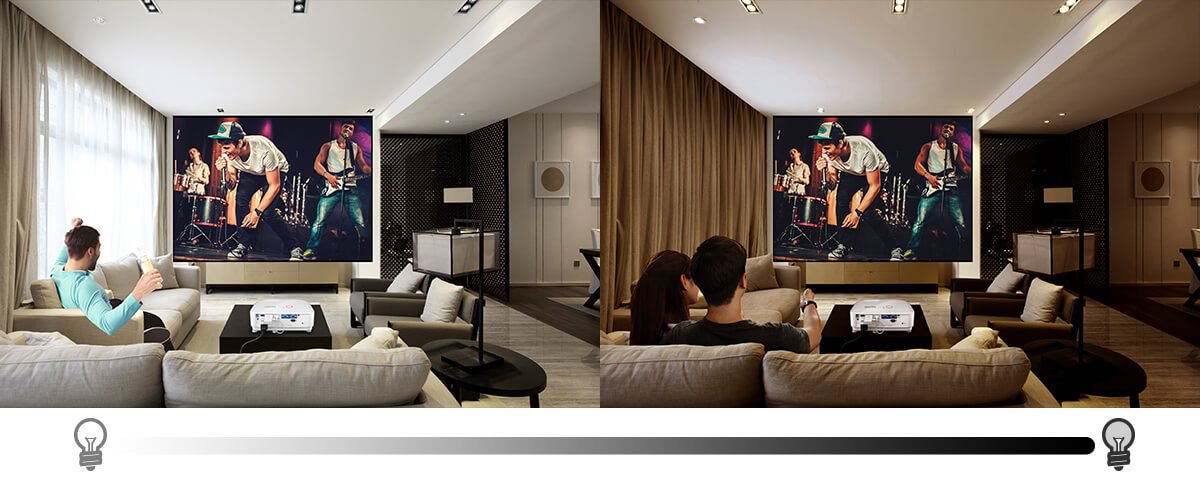
The “true”, hardware-determined resolution of a display source. Currently, common resolutions include full HD (1920 x 1080) or 1080p and ultra HD (3840 x 2160) or 2160p, the “p” standing for progressive scan. Measured in pixels along two axes, or in megapixels per frame.
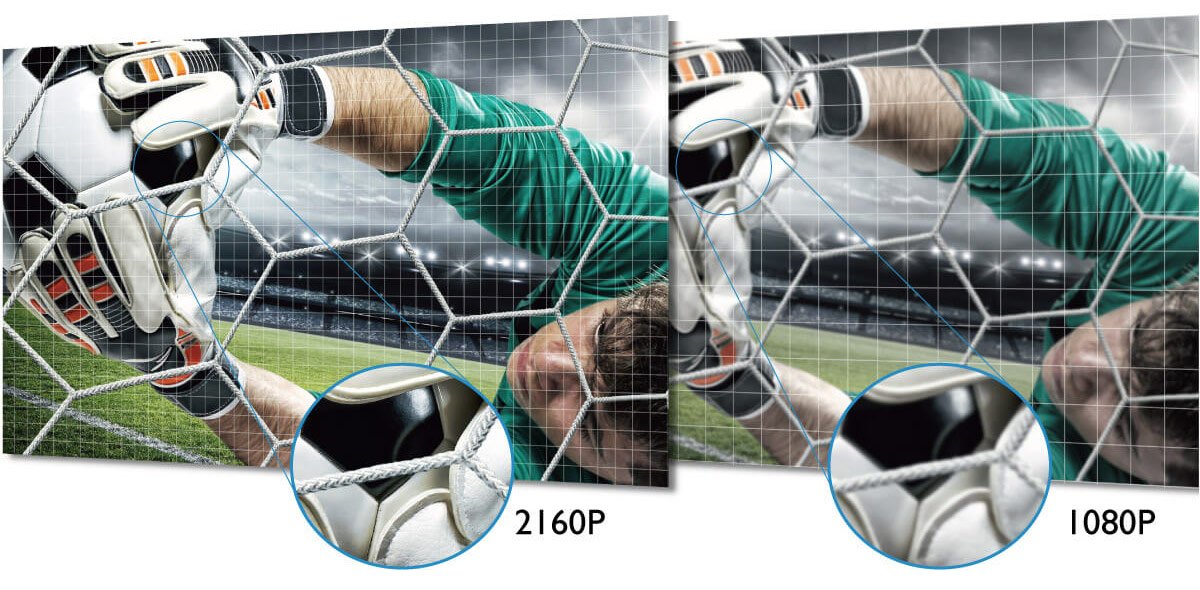
On screen display. The user interface that shows up on a display when prompted by a remote control or buttons on the display itself. Ideally very minimal and intuitive.
Rec. 709 is a color gamut standard that enables a projector to deliver colors so real that they reflect what the human eye perceives. It's one of the most common color spaces for content presented in full HD or higher resolutions. By specifying the range of colors that can be displayed on an HD device, Rec. 709 ensures consistent and accurate color reproduction across different devices, resulting in a more lifelike and immersive viewing experience.
RGB stands for red, green, and blue, which are the primary colours of light that are used to create a wide range of colours on a projector.
Learn more: What is an RGBRGB colour wheel?
An effect caused by devices that struggle to fill up pixels, or generate an image, fast enough. Results in a grid-like anomaly that resembles a screen door, hence the name. This can make the image appear less sharp or detailed and be distracting for some viewers. One way to reduce the screen door effect is to increase the resolution of the projector. Higher resolution projectors have more pixels per inch, resulting in a smoother image with less visible gaps or lines between pixels. Other factors such as lens quality, image processing, and color accuracy can also impact the overall image quality and affect the screen door effect.
Tab tension is a feature found in certain types of projector screens that helps to ensure a flat and smooth screen surface for the best possible image quality. By applying a constant tension to the screen material, tab tension eliminates any wrinkles, creases, or waves that can occur over time, resulting in a more immersive and enjoyable viewing experience. While tab tension is an important feature of some projector screens, it's not necessary for all types of installations. If you're using a fixed-frame screen that's properly tensioned and installed, you may not need the additional tab tension feature.
Throw distance is the distance between the projector and the screen that affects the projected image's size, brightness, and clarity. Short-throw projectors are ideal for smaller rooms or when space is limited, while standard-throw projectors are suitable for most types of installations. Long-throw projectors are designed for larger rooms or outdoor installations.
Processing of an image to increase its resolution. For example, most 4K TVs and projectors can upscale 1080p content to 2160p, but the process may cause image compromise.
Very useful projector feature, allows maintaining image size from different throw distances. Fixed lens projectors that can’t zoom have to be physically moved when changing screen sizes, a very cumbersome process.
{{title}}
We will notify you when the product becomes available
We will send you an email once the product becomes available.
Sorry, our store is currently down for maintenance.We should be back shortly. Thank you for your patience!
The requested qty is not available
The requested qty exceeds the maximum qty allowed in shopping cart
Product that you are trying to add is not available.